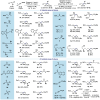Metal-Catalyzed Hydrogen Atom Transfer (MHAT) Hydroalkylation with Electron-Deficient Alkynes
- PMID: 39606916
- PMCID: PMC11650775
- DOI: 10.1021/acs.orglett.4c03943
Metal-Catalyzed Hydrogen Atom Transfer (MHAT) Hydroalkylation with Electron-Deficient Alkynes
Abstract
We present a novel strategy for olefin construction via the reductive coupling of electron-neutral alkenes with electron-deficient alkynes under metal-catalyzed hydrogen atom transfer conditions. This methodology provides selective access to both trans and the more challenging-to-synthesize cis isomers and permits the olefin to be installed next to sterically hindered centers, key factors in the synthesis of biologically active compounds. The reaction exhibits broad functional group tolerance and proceeds under mild, nontoxic conditions with high atom efficiency.
Conflict of interest statement
The authors declare no competing financial interest.
Figures



References
-
- Silvi M.; Aggarwal V. K. Radical Addition to Strained σ-Bonds Enables the Stereocontrolled Synthesis of Cyclobutyl Boronic Esters. J. Am. Chem. Soc. 2019, 141, 9511–9515. 10.1021/jacs.9b03653. - DOI - PubMed
- Yang B.; Lu S.; Wang Y.; Zhu S. Diverse synthesis of C2-linked functionalized molecules via molecular glue strategy with acetylene. Nat. Commun. 2022, 13, 1858.10.1038/s41467-022-29556-2. - DOI - PMC - PubMed
- Paul S.; Filippini D.; Silvi M. Polarity Transduction Enables the Formal Electronically Mismatched Radical Addition to Alkenes. J. Am. Chem. Soc. 2023, 145, 2773–2778. 10.1021/jacs.2c12699. - DOI - PMC - PubMed
-
- Garwood J. J. A.; Chen A. D.; Nagib D. A. Radical Polarity. J. Am. Chem. Soc. 2024, 146, 28034–28059. - PubMed
-
- Giese B. Formation of CC Bonds by Addition of Free Radicals to Alkenes. Angew. Chem., Int. Ed. Engl. 1983, 22, 753–764. 10.1002/anie.198307531. - DOI
- Srikanth G. S. C.; Castle S. L. Advances in radical conjugate additions. Tetrahedron. 2005, 61, 10377–10441. 10.1016/j.tet.2005.07.077. - DOI
- Kitcatt D. M.; Nicolle S.; Lee A. L. Direct decarboxylative Giese reactions. Chem. Soc. Rev. 2022, 51, 1415–1453. 10.1039/D1CS01168E. - DOI - PubMed
-
- Dieter R. K.; Alexander C. W.; Nice L. E. Conjugate Addition Reactions of α-Aminoalkylcuprates with α,β-Enones and Enals. Tetrahedron. 2000, 56, 2767–2778. 10.1016/S0040-4020(00)00130-7. - DOI
- Yan X.; Harutyunyan S. R. Catalytic enantioselective addition of organometallics to unprotected carboxylic acids. Nat. Commun. 2019, 10, 3402.10.1038/s41467-019-11345-z. - DOI - PMC - PubMed
LinkOut - more resources
Full Text Sources

